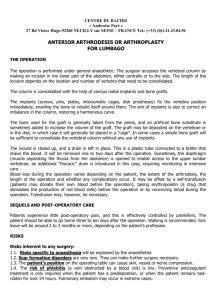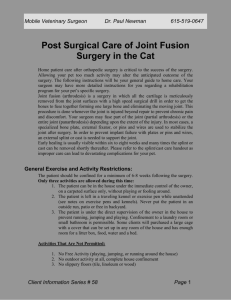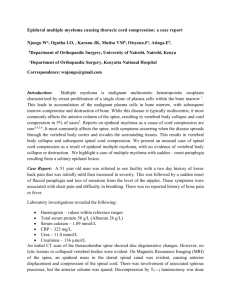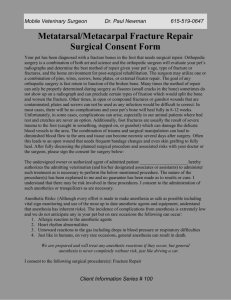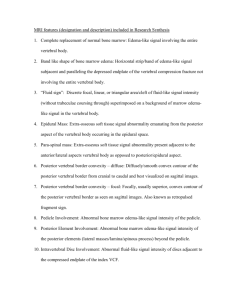FICHE CLE-ang - Centre du Rachis
advertisement
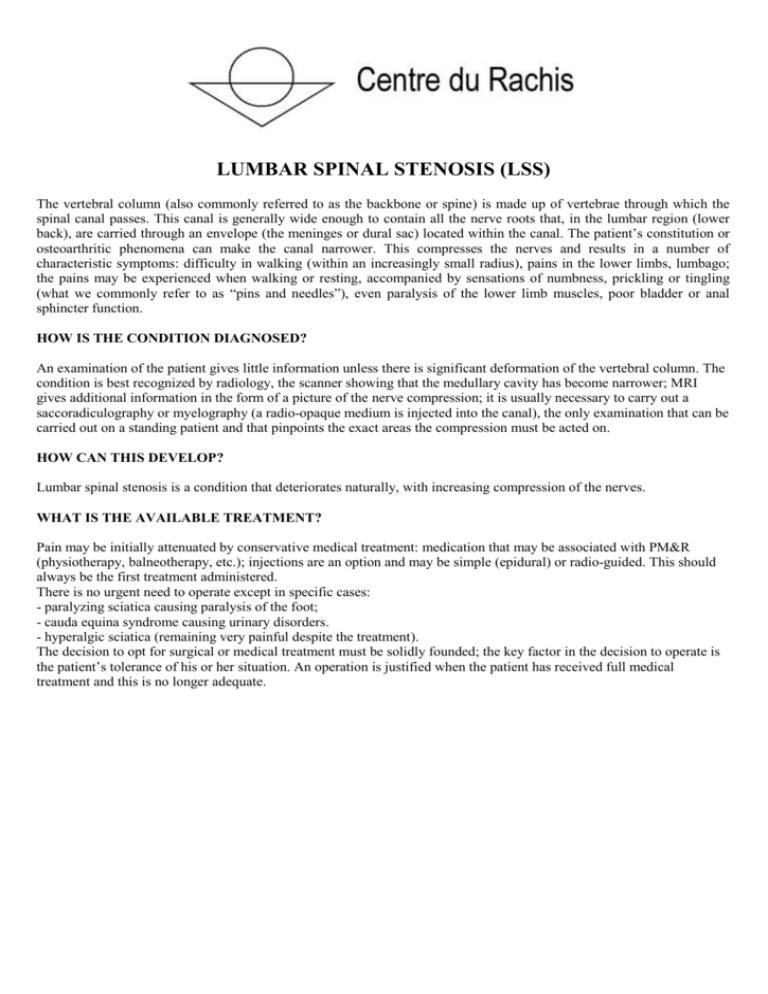
LUMBAR SPINAL STENOSIS (LSS) The vertebral column (also commonly referred to as the backbone or spine) is made up of vertebrae through which the spinal canal passes. This canal is generally wide enough to contain all the nerve roots that, in the lumbar region (lower back), are carried through an envelope (the meninges or dural sac) located within the canal. The patient’s constitution or osteoarthritic phenomena can make the canal narrower. This compresses the nerves and results in a number of characteristic symptoms: difficulty in walking (within an increasingly small radius), pains in the lower limbs, lumbago; the pains may be experienced when walking or resting, accompanied by sensations of numbness, prickling or tingling (what we commonly refer to as “pins and needles”), even paralysis of the lower limb muscles, poor bladder or anal sphincter function. HOW IS THE CONDITION DIAGNOSED? An examination of the patient gives little information unless there is significant deformation of the vertebral column. The condition is best recognized by radiology, the scanner showing that the medullary cavity has become narrower; MRI gives additional information in the form of a picture of the nerve compression; it is usually necessary to carry out a saccoradiculography or myelography (a radio-opaque medium is injected into the canal), the only examination that can be carried out on a standing patient and that pinpoints the exact areas the compression must be acted on. HOW CAN THIS DEVELOP? Lumbar spinal stenosis is a condition that deteriorates naturally, with increasing compression of the nerves. WHAT IS THE AVAILABLE TREATMENT? Pain may be initially attenuated by conservative medical treatment: medication that may be associated with PM&R (physiotherapy, balneotherapy, etc.); injections are an option and may be simple (epidural) or radio-guided. This should always be the first treatment administered. There is no urgent need to operate except in specific cases: - paralyzing sciatica causing paralysis of the foot; - cauda equina syndrome causing urinary disorders. - hyperalgic sciatica (remaining very painful despite the treatment). The decision to opt for surgical or medical treatment must be solidly founded; the key factor in the decision to operate is the patient’s tolerance of his or her situation. An operation is justified when the patient has received full medical treatment and this is no longer adequate. OPERATING ON LUMBAR SPINAL STENOSIS EXPECTED GOALS AND BENEFITS The aim of the operation is to relieve pain on the lower limbs, improving walking ability if this was restricted. Operations are successful in 80% of cases. The result is often less satisfactory on low back pains for which complete relief should not be expected. These pains often delay a patient’s return to work, especially in professions that are physically very demanding. THE OPERATION The aim of the operation is to remove nerve compression. To do this, some of the tissue obstructing the canal (bone formations, joint surfaces, and ligaments, even part of the intervertebral disks) must be removed. Surgery varies according to the type of stenosis. Generally, the operation consists of removing bone fragments (lamina) by laminectomy, joint surfaces (by a generally partial arthrectomy), or compressive ligament tissues. Sometimes it is also necessary to remove part of an intervertebral disk forming a hernia or that has become ossified. In some cases, more material has to be removed, at the risk of disturbing the vertebral balance. The vertebral column can become unstable, causing a recurrence of nerve root compression and leading to lumbago. In this case, the vertebrae must be fixed to eliminate all mobility. This operation is called arthrodesis. Various types of metallic parts (implants, or osteosynthesis) are used, as are bone grafts. The implants deliver immediate stability, enabling bone fusion. The bone graft can be sourced from the surgical site, the pelvis, but bone substitutes can also be used. Usually, the material is not removed. SEQUELS AND POST-OPERATORY CARE • After the operation, the patient experiences unpleasant pain in the region of the operation and in the back. This is generally very effectively relieved by analgesics (painkillers). • Urinary difficulties frequently appear during the 24 hours immediately following the operation (when a urinary catheter was not initially introduced). Unpleasant intestinal bloating may also occur. Should paralyses or sensory disorders occur or worsen in the buttocks and/or the anus region, you should inform us immediately. • To prevent the newly fused vertebrae from having to cope with excessive constraints, the patient may not be allowed to take up a seated position for some time, and the wearing of a corset may also be recommended for a variable length of time: your surgeon or physiotherapist will provide details. RISKS: RISKS INHERENT TO ANY SURGERY. Anaesthesia brings its own risks (the anaesthetist will provide all the necessary explanations when you consult prior to the operation; this consultation is mandatory). Most medical, curative or even preventive treatment (such as anticoagulants or antibiotics), even usually considered banal or harmless, bring their own risks of complication (bruising, haemorrhage, allergy, etc.) or side-effects (digestive, blood, skin, etc.). In general, the acceptance of a risk of complication or incident, even very rare, but potentially serious, is the inevitable corollary of the proposed treatment, even medical. Similarly, failure or refusal to accept treatment cannot be completely risk-free either. Surgery has limits and can never reproduce an organ or joint that is a perfect identikit of nature; inevitable sequels (if only scars), usually minor, must be accepted as the downside of the benefit enjoyed; results can never be guaranteed, even with the most proven and reliable techniques. Most of these complications heal without sequels, while others require appropriate treatment, sometimes even further surgery; some may leave serious and irreversible functional sequels. WHAT RISKS ARE SPECIFIC TO THIS SURGERY? • Disorders in lower limb sensitivity (numbness), that may recur or intensify. Experience shows that generally they gradually disappear. • The risk of a partial or total paralysis of a muscular segment (most often in the foot). This may be temporary, but can be irreversible. • The risk of leaking cephalorachidian liquid can force a patient to be bedridden for four to five days. This complication can occur even if meninges broken during surgery have been stitched up. • Like any operation involving a bone graft, the risk of failure to consolidate cannot be excluded and will be increased by: diabetes, arteritis, smoking and alcohol. • The risk of infection remains lower than 1% but cannot be totally discounted. It is often linked to the terrain (obesity, smoking, diabetes). The main thing is to address it with the help of a doctor specialized in infectious diseases. • Some risks are connected with the patient’s position, lying face down, during the operation: ocular compression leading to major sight disorders, the nerves in the lower or upper limbs may be compressed; in rare cases, these lesions persist. • Blood clots (thrombosis) may form and a vessel may migrate or become obstructed (embolism), while vascular wounds are very rare. All the above information meets the most recent legal requirements for preoperative patient guidance. This fact sheet has been designed to recapitulate what the surgeon will have said to you at consultations prior to the decision to operate. It may contain additional information. The points discussed at meetings with the surgeon may be adapted to each patient, and at the latter’s request; these consultations give the surgeon the chance to answer the patient’s questions and form the main body of information provided. The fact sheets have been produced by the Société Française de Chirurgie du Rachis (the French Back Surgeons Association. PATIENT’S FAMILY NAME, FIRST NAME: Signature, date, preceded by the words “lu, compris et approuvé” indicating that the patient has read, understood and accepted the above





